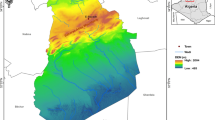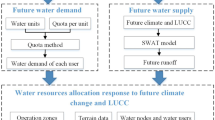Abstract
In this study, an integrated simulation-based allocation modeling system (ISAMS) is developed for identifying water resources management strategies in response to climate change. The ISAMS incorporates global climate models (GCMs), a semi-distributed land use-based runoff process (SLURP) model, and a multistage interval-stochastic programming (MISP) approach within a general framework. The ISAMS can not only handle uncertainties expressed as probability distributions and interval values but also reveal climate change impacts on water resources allocation under different projections of GCMs. The ISAMS is then applied to the Kaidu-kongque watershed with cold arid characteristics in the Tarim River Basin (the largest inland watershed basin in China) for demonstrating its efficiency. Results reveal that different climate change models corresponding to various projections (e.g., precipitation and temperature) would lead to changed water resources allocation patterns. Variations in water availability and demand due to uncertainties could result in different water allocation targets and shortages. A variety of decision alternatives about water allocations adaptive to climate change are generated under combinations of different global climate models and ecological water release plans. These findings indicate that understanding the uncertainties in water resources system, building adaptive methods for generating sustainable water allocation patterns, and taking actions for mitigating water shortage problems are key adaptation strategies responding to climate change.













Similar content being viewed by others
References
Arnell NW, van Vuuren DP, Isaac M (2011) The implications of climate policy for the impacts of climate change on global water resources. Glob Environ Chang 21:592–603
Ashraf VS, Mousavi SJ, Abbaspour KC, Srinivasan R, Arnold JR (2015) Integration of hydrological and water allocation models in basin-scale water resources management considering crop pattern and climate change: Karkheh River Basin in Iran. Reg Environ Chang 15(3):475–484
Bpzkurt D, Sen OL (2013) Climate change impacts in the Euphrates-Tigris Basin based on different model and scenario simulations. J Hydrol 480:149–161
Cai XM, Zeng RJ, Kang WH, Song JH, J. Valocchi A (2015) Strategic planning for drought mitigation under climate change. J Water Resour Plan Manag 141(9): DOI:10.1061/(ASCE)WR.1943-5452.0000510
Chen GH, Yang J, Chen YN, Zhang SH, Deng HJ, Liu HM, De Maeyer P (2015) Climate change impact on the hydrology of a typical watershed in the Tianshan Mountains. Adv Meteorol. doi:10.1155/2015/960471
Dessai S, Hulme M (2007) Assessing the robustness of adaptation decisions to climate change uncertainties: a case study on water resources management in the East of England. Glob Environ Chang 17:59–72
Dixon RK (2000) The global carbon cycle and global change: responses and feedbacks from the Mycorrhizosphere. Mycorrhizal Biol:85–89
Dixon RK (2007) Advancing towards a hydrogen energy economy: status, opportunities and barriers. Mitig Adapt Strateg Glob Chang 12:325–341
Dixon RK, Scheer RM, Williams GT (2011) Sustainable energy investments: contributions of the global environment facility. Mitig Adapt Strateg Glob Chang 16:83–102
Feulner G (2017) Global challenges: climate change. Global Challenges 1(1):5–6
Gosling SN, Aenell NW (2016) A global assessment of the impact of climate change on water scarcity. Clim Chang 134:371–385
Haidera M, Saif Ali A, Abdulla N, Alkhatib AK, Anwar N, Amanda F, Bill D, Chris S (2011) Water scarcity and climate change adaptation for Yemen’s vulnerable communities. Local Environ 16(5):473–488
Henderson J, Rodgers C, Jones R, Smith J, Strzepek K, Martinich J (2015) Economic impacts of climate change on water resources in the coterminous United States. Mitig Adapt Strateg Glob Chang 20(1):125–157
Huang GH, Loucks DP (2000) An inexact two-stage stochastic programming model for water resources management under uncertainty. Civ Eng Environ Syst 17:95–118
Huang Y, Li YP, Chen X, Bao AM, Ma YG (2013) A multistage simulation-based optimization model for water resources management in Tarim River Basin, China. Stoch Env Res Risk A 27(1):147–158
Kite G (1993) Application of a land-use hydrological model to climatic change. Water Resour Res 29(7):2377–2384
Kite G (2001) Modelling the Mekong: hydrological simulation for environmental impact studies. J Hydrol 253:1–13
Lespinas F, Ludwig W, Heussner S (2014) Hydrological and climatic uncertainties associated with modeling the impact of climate change on water resources of small Mediterranean coastal rivers. J Hydrol 511:403–422
Li YP, Huang GH (2009) Fuzzy-stochastic-based violation analysis method for planning water resources management systems with uncertain information. Inf Sci 179:4261–4276
Li YP, Huang GH, Nie SL (2009a) Water resources management and planning under uncertainty: an inexact multistage joint-probabilistic programming method. Water Resour Manag 23:2515–2538
Li YP, Huang GH, Huang YF, Zhou HD (2009b) A multistage fuzzy-stochastic programming model for supporting sustainable water-resources allocation and management. Environ Model Softw 24:786–797
Liew MW, Veith TL, Bosch DD, Arnold JG (2007) Suitability of SWAT for the conservation effects assessment project: a comparison on USDA agricultural research service watersheds. J Hydrol Eng 12(2):173–189
Liu J, Li YP, Huang GH, Zeng XT (2014) A dual-interval fixed-mix stochastic programming method for water resources management under uncertainty. Resour Conserv Recycl 88:50–66
Liu HL, Willems P, Bao AM, Wang L, Chen X (2016) Effect of climate change on the vulnerability of a socio-ecological system in an arid area. Glob Planet Chang 137:1–9
Ma C, Pan SL, Wang GQ, Liao YF, Xu YP (2016) Changes in precipitation and temperature in Xiangjiang River Basin, China. Theor Appl Climatol 123(3):859–871
Miller KA, Belton V (2014) Water resources management and climate change adaptation: a holistic and multiple criteria perspective. Mitig Adapt Strateg Glob Chang 19(3):289–308
Misra AK (2013) Climate change impact, mitigation and adaptation strategies for agricultural and water resources, in Ganga Plain (India). Mitig Adapt Strateg Glob Chang 18:673–689
Motovilov YG, Gottschalk L, Engeland K, Rodhe A (1999) Validation of a distributed hydrological model against spatial observations. Agric For Meteorol 98-99:257–277
Nematian J (2016) An extended two-stage stochastic programming approach for water resources management under uncertainty. J Environ Inform 27(2):72–84
Qin XS, Lu Y (2014) Study of climate-change impact on flood frequencies: a combined weather generator and hydrological modeling approach. J Hydrometeorol 15:1205–1219
Refsgaard JC, Nielsen KA, Drews M, Halsnæs K, Jeppesen E, Madsen H, Markandya A, Olesen JE, Porter JR, Christense JH (2013) The role of uncertainty in climate change adaptation strategies—a Danish water management example. Mitig Adapt Strateg Glob Chang 18:337–359
Salinas CX, Gironás J, Pinto M (2016) Water security as a challenge for the sustainability of La Serena-Coquimbo conurbation in northern Chile: global perspectives and adaptation. Mitig Adapt Strateg Glob Chang 21(8):1235–1246
Semenov MA, Stratonovitch P (2010) Use of multi-model ensembles from global climate models for assessment of climate change impacts. Clim Res 41(1):1–14
Skrzypek G, Dogramaci S, Rouillard A, Grierson PF (2016) Groundwater seepage controls salinity in a hydrologically terminal basin of semi-arid northwest Australia. J Hydrol 542:627–636
Sun J, Li YP, Huang GH, Wang CX (2016) Analysis of interactive effects of DEM resolution and basin subdivision level on runoff simulation in Kaidu River Basin. China Hydrol Res. doi:10.2166/nh.2016.332
Tennant DL (1976) Instream flow regimens for fish, wildlife, recreation, and related environmental resources. Proceedings of Symposium and Specialty Conference on Instream Flow Needs II American Fisheries Society, Bethesda, pp 359–373
Tzabiras J, Vasiliades L, Sidiropoulos P, Loukas A, Mylopoulos N (2016) Evaluation of water resources management strategies to overturn climate change impacts on Lake Karla watershed. Water Resour Manag 30(15):5819–5844
Wang XJ, Zhang JY, Shahid S, Guan EH, Wu YX, Gao J, He RM (2016) Adaptation to climate change impacts on water demand. Mitig Adapt Strateg Glob Chang 21:81–99
Wang GQ, Zhang JY, Jin JL, Weinberg J, Bao ZX, Liu CS, Liu YL, Yan XL, Song XM, Zhai R (2017) Impacts of climate change on water resources in the Yellow River basin and identification of global adaptation strategies. Mitig Adapt Strateg Glob Chang 22:67–83
Zarch MAA, Sivakumar B, Sharma A (2015) Assessment of global aridity change. J Hydrol 520:300–313
Zhuang XW, Li YP, Huang GH, Liu J (2015) Assessment of climate-change impacts on watershed in cold-arid region: an integrated multi-GCM-based stochastic weather generator and stepwise cluster analysis method. Clim Dyn 47:191–201
Acknowledgements
This research was supported by the National Key Research Development Program of China (2016YFA0601502) and the National Natural Sciences Foundation (51379075 and 51520105013). The authors are grateful to the editors and the anonymous reviewers for their insightful comments and helpful suggestions.
Author information
Authors and Affiliations
Corresponding author
Rights and permissions
About this article
Cite this article
Sun, J., Li, Y.P., Zhuang, X.W. et al. Identifying water resources management strategies in adaptation to climate change under uncertainty. Mitig Adapt Strateg Glob Change 23, 553–578 (2018). https://doi.org/10.1007/s11027-017-9749-9
Received:
Accepted:
Published:
Issue Date:
DOI: https://doi.org/10.1007/s11027-017-9749-9




